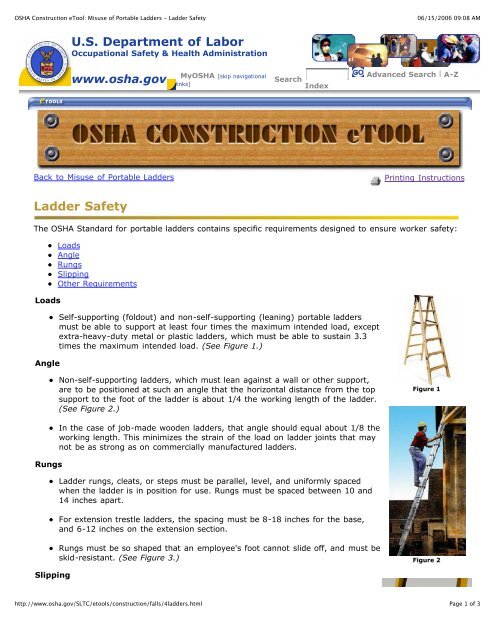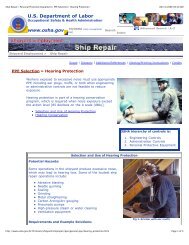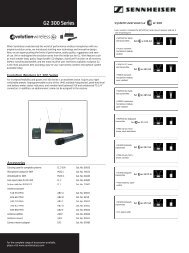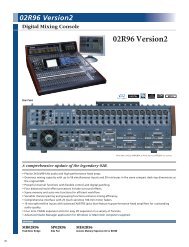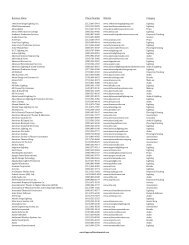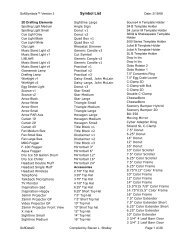Ladder Safety - stagecraft fundamentals
Ladder Safety - stagecraft fundamentals
Ladder Safety - stagecraft fundamentals
- No tags were found...
Create successful ePaper yourself
Turn your PDF publications into a flip-book with our unique Google optimized e-Paper software.
OSHA Construction eTool: Misuse of Portable <strong>Ladder</strong>s - <strong>Ladder</strong> <strong>Safety</strong>06/15/2006 09:08 AMU.S. Department of LaborOccupational <strong>Safety</strong> & Health Administrationwww.osha.govMyOSHA [skip navigationallinks]SearchIndexAdvanced Search | A-ZBack to Misuse of Portable <strong>Ladder</strong>s Printing Instructions<strong>Ladder</strong> <strong>Safety</strong>The OSHA Standard for portable ladders contains specific requirements designed to ensure worker safety:LoadsAngleLoadsAngleRungsSlippingOther RequirementsSelf-supporting (foldout) and non-self-supporting (leaning) portable laddersmust be able to support at least four times the maximum intended load, exceptextra-heavy-duty metal or plastic ladders, which must be able to sustain 3.3times the maximum intended load. (See Figure 1.)Non-self-supporting ladders, which must lean against a wall or other support,are to be positioned at such an angle that the horizontal distance from the topsupport to the foot of the ladder is about 1/4 the working length of the ladder.(See Figure 2.)Figure 1RungsIn the case of job-made wooden ladders, that angle should equal about 1/8 theworking length. This minimizes the strain of the load on ladder joints that maynot be as strong as on commercially manufactured ladders.<strong>Ladder</strong> rungs, cleats, or steps must be parallel, level, and uniformly spacedwhen the ladder is in position for use. Rungs must be spaced between 10 and14 inches apart.For extension trestle ladders, the spacing must be 8-18 inches for the base,and 6-12 inches on the extension section.Rungs must be so shaped that an employee's foot cannot slide off, and must beskid-resistant. (See Figure 3.)Figure 2Slippinghttp://www.osha.gov/SLTC/etools/construction/falls/4ladders.htmlPage 1 of 3
OSHA Construction eTool: Misuse of Portable <strong>Ladder</strong>s - <strong>Ladder</strong> <strong>Safety</strong>06/15/2006 09:08 AM<strong>Ladder</strong>s are to be kept free of oil, grease, wet paint, and other slippinghazards.Wood ladders must not be coated with any opaque covering, exceptidentification or warning labels on one face only of a side rail.Other RequirementsFoldout or stepladders must have a metal spreader or locking device to holdthe front and back sections in an open position when in use. (See Figure 4.)Figure 3When two or more ladders are used to reach a work area, they must be offsetwith a landing or platform between the ladders.The area around the top and bottom of ladder must be kept clear.<strong>Ladder</strong>s must not be tied or fastened together to provide longer sections,unless they are specifically designed for such use. (See Figure 5.)Figure 4Never use a ladder for any purpose other than the one for which it wasdesigned.Additional Information:Figure 529 CFR 1926 Subpart X, <strong>Ladder</strong>s. OSHA Standard.1926.1053, <strong>Ladder</strong>s1926.1053(a)Additional ExamplesAdditional ExamplesThis is improperly using thetop rung of this step ladderto work from.http://www.osha.gov/SLTC/etools/construction/falls/4ladders.htmlPage 2 of 3
OSHA Construction eTool: Misuse of Portable <strong>Ladder</strong>s - <strong>Ladder</strong> <strong>Safety</strong>06/15/2006 09:08 AMBack to Top www.osha.gov www.dol.govContact Us | Freedom of Information Act | Customer SurveyPrivacy and Security Statement | DisclaimersOccupational <strong>Safety</strong> & Health Administration200 Constitution Avenue, NWWashington, DC 20210http://www.osha.gov/SLTC/etools/construction/falls/4ladders.htmlPage 3 of 3


